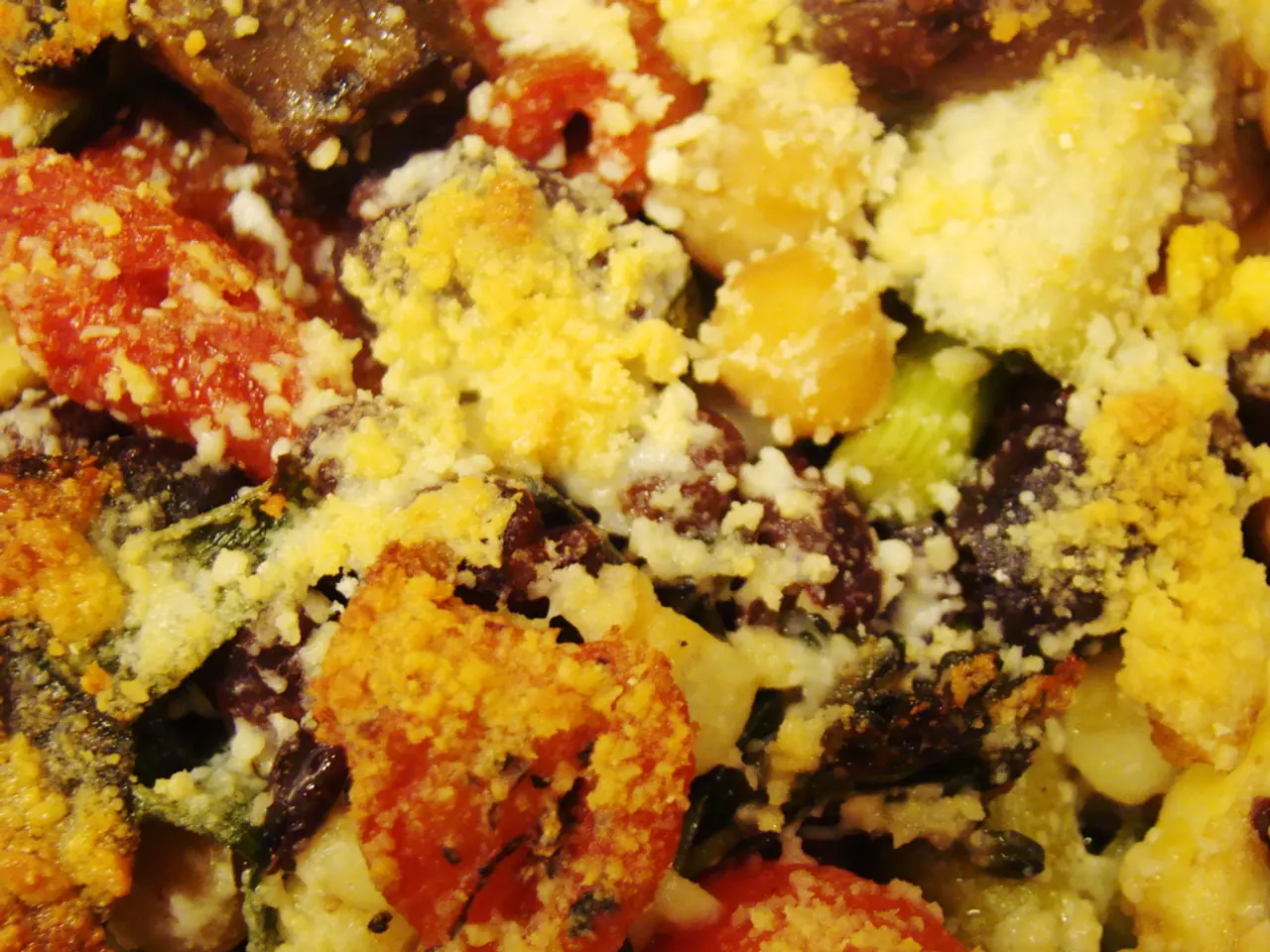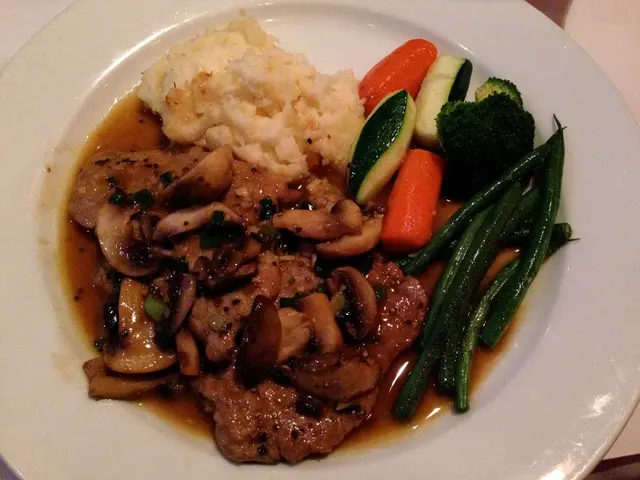Daily diet plan designed to decrease triglyceride levels
================================================================================
Are you looking to manage your triglyceride levels? This article provides a 7-day meal plan to help reduce triglycerides, along with dietary changes and lifestyle measures that can support triglyceride reduction.
Triglycerides are a type of fat in the body, making them the most common type of fat. Excess energy from consuming more calories than needed from other foods, such as carbohydrates, is converted to and stored as triglycerides. To lower triglyceride levels, focus on dietary changes that include increasing intake of foods rich in omega-3 fatty acids, soluble fiber, and healthy fats, while reducing added sugars and refined carbohydrates.
Key foods and dietary changes to help lower triglycerides include:
- Fatty fish: High in omega-3s which reduce triglycerides. Examples include salmon, mackerel, and sardines; aim for 2+ servings per week.
- Nuts and seeds: Contain healthy unsaturated fats and fiber. Examples include almonds, walnuts, and chia seeds; aim for a small daily handful.
- Soluble fiber-rich grains: Binds cholesterol and slows digestion. Examples include oats and barley.
- Legumes: Rich in soluble fiber and plant protein; stabilize blood sugar. Examples include lentils, chickpeas, and black beans.
- Avocado: High in monounsaturated fats and fiber. Use as a butter or cheese substitute.
- Flaxseeds and walnuts: Plant sources of omega-3 fats. Add to meals or smoothies.
- Reduce refined carbs and sugars: Excess sugars convert to triglycerides. Limit sugary drinks, sweets, white bread, and pasta.
Additional lifestyle measures that support triglyceride reduction include regular physical activity, maintaining a healthy weight, limiting alcohol intake, and quitting smoking.
Omega-3 supplements can further reduce triglycerides but are best taken under medical supervision. Regular lipid profile testing is important to monitor progress, especially if you have risk factors like diabetes or obesity.
Guggul, an herbal supplement, could be as effective as prescription medication at reducing triglyceride levels. Curcumin supplements may also cause a significant decrease in triglycerides and LDL cholesterol. Fenugreek supplementation may help reduce blood triglycerides and other biomarkers of metabolic syndrome. Garlic extract may help reduce triglyceride levels due to its antioxidant properties.
The desirable level of fasting blood triglycerides is less than 90 mg/dl for children older than 10 years and for children younger than 10 years. High levels of triglycerides in the blood can increase the risk for insulin resistance, obesity, pancreatitis, type 2 diabetes, and cardiovascular disease.
Here's a sample 7-day meal plan to help reduce triglycerides:
Day 1 - Breakfast: Whole grain cereal or rolled oats - Lunch: Vegetable and lentil soup, sardines in a whole grain wrap, and a spinach, avocado, and tomato salad - Dinner: Grilled salmon or mackerel - Snack: A banana and almonds
Day 2 - Breakfast: Old fashioned oats or buckwheat pancakes - Lunch: Tofu and butternut squash curry - Dinner: Chicken and vegetable stir-fry - Snack: A boiled egg and fresh fruit
Day 3 - Breakfast: Whole grain toast - Lunch: Vegetable and bean chili - Dinner: Grilled steak - Snack: Celery sticks and almond butter
Day 4 - Breakfast: Whole grain cereal or rolled oats - Lunch: Salad with avocado, olives, and grilled chicken - Dinner: Whole grain pasta with a tomato and vegetable sauce - Snack: Walnuts
Day 5 - Breakfast: Old fashioned oats or buckwheat pancakes - Lunch: Sardines in a whole grain wrap, with a side of mixed greens and cherry tomatoes - Dinner: Grilled salmon or mackerel - Snack: Strawberries
Day 6 - Breakfast: Whole grain toast - Lunch: Lentil soup with a side of mixed greens - Dinner: Tofu and butternut squash curry - Snack: A banana and almonds
Day 7 - Breakfast: Whole grain cereal or rolled oats - Lunch: Chicken and vegetable stir-fry - Dinner: Grilled steak - Snack: Celery sticks and almond butter
[1] American Heart Association. (2021). Triglycerides. [online] Available at: https://www.heart.org/en/health-topics/cholesterol/understanding-triglycerides [2] American Heart Association. (2021). Lifestyle Changes to Lower Triglycerides. [online] Available at: https://www.heart.org/en/health-topics/cholesterol/understanding-triglycerides/lifestyle-changes-to-lower-triglycerides [3] Mayo Clinic. (2021). Triglycerides: Why they matter and how to lower them. [online] Available at: https://www.mayoclinic.org/diseases-conditions/high-blood-cholesterol/in-depth/triglycerides/art-20046418 [4] National Institute of Diabetes and Digestive and Kidney Diseases. (2021). High Triglycerides. [online] Available at: https://www.niddk.nih.gov/health-information/diabetes/overview/what-is-diabetes/prediabetes-and-risk-factors/high-triglycerides [5] Harvard T.H. Chan School of Public Health. (2021). Triglycerides: What You Need to Know. [online] Available at: https://www.hsph.harvard.edu/nutritionsource/triglycerides/
- This meal plan is designed to help predict and reduce your triglyceride levels, focusing on foods like fatty fish, nuts, seeds, vegetables, lentils, and avocado, which are rich in omega-3s, fiber, and healthy fats.
- Aim for at least two servings per week of fatty fish, like salmon, mackerel, and sardines, in your carbohydrate-based meals.
- Snacks like nuts and seeds, such as almonds, walnuts, and chia seeds, can provide healthy unsaturated fats and fiber to support triglyderide reduction.
- Dietary changes to lower triglycerides include reducing refined carbs and sugars, limiting sugary drinks, sweets, white bread, and pasta.
- A healthy meal plan, regular physical activity, maintaining a healthy weight, limiting alcohol intake, and quitting smoking could help in managing heart health, triglyceride levels, and overall health-and-wellness.
- Science suggests that omega-3 supplements, guggul, curcumin, fenugreek supplementation, and garlic extract might further reduce triglycerides, but it's best to consult healthcare professionals for guidance.
- High levels of triglycerides in the blood can lead to insulin resistance, obesity, pancreatitis, type 2 diabetes, and cardiovascular disease, so it's crucial to monitor your triglyceride levels regularly, especially if you have risk factors like diabetes or obesity.
- A vegetarian 7-day meal plan includes whole grain cereal, rolled oats, vegetables, lentil soup, sardines, tofu, chicken, grilled salmon or mackerel, avocado, grilled steak, mixed greens, and fruits for breakfast, lunch, dinner, and snacks.
- Planning your nutrition around these suggestions can contribute to a low-triglyceride, healthy, and balanced diet, which improves fitness-and-exercise performance and overall wellness.






